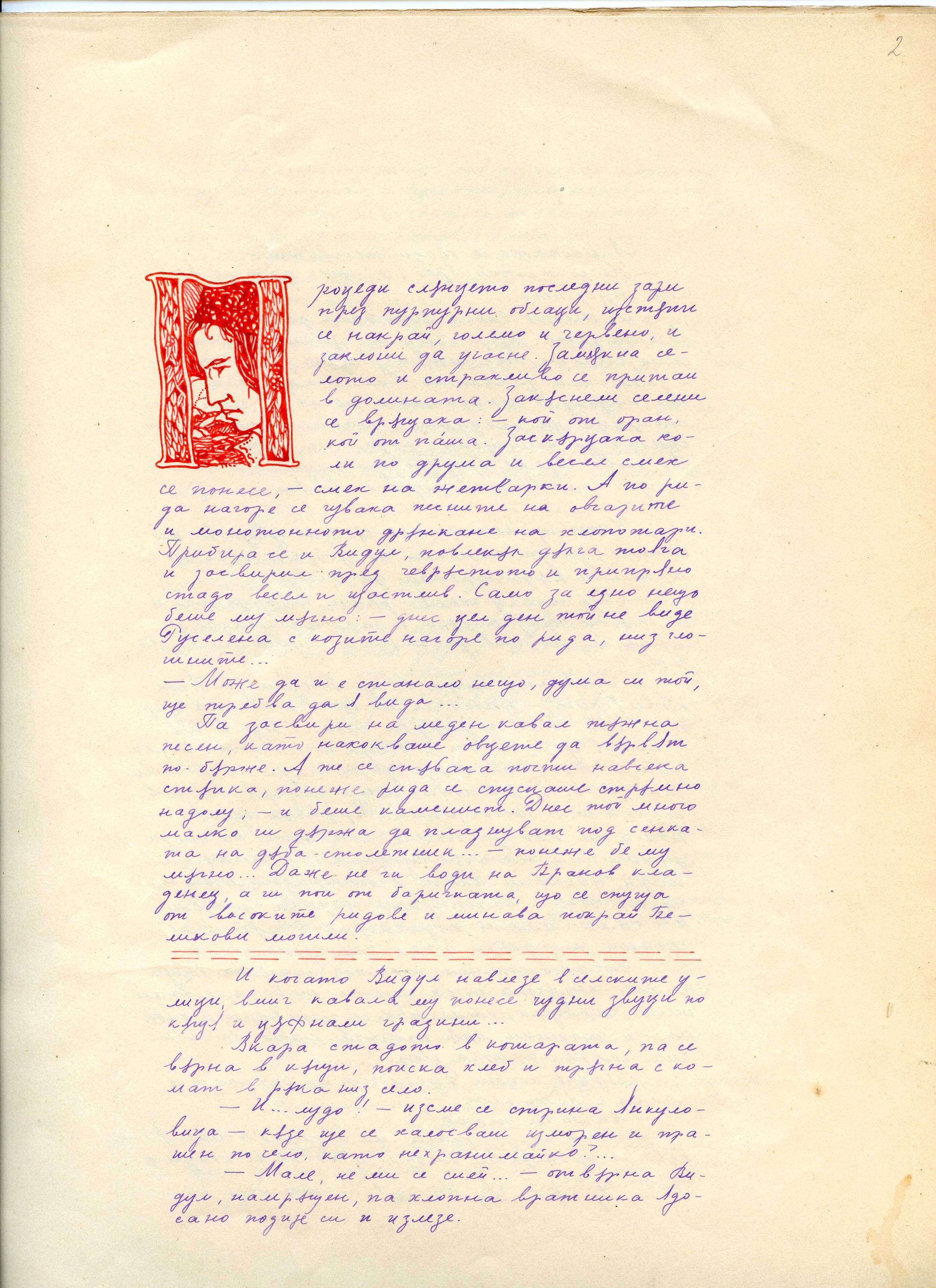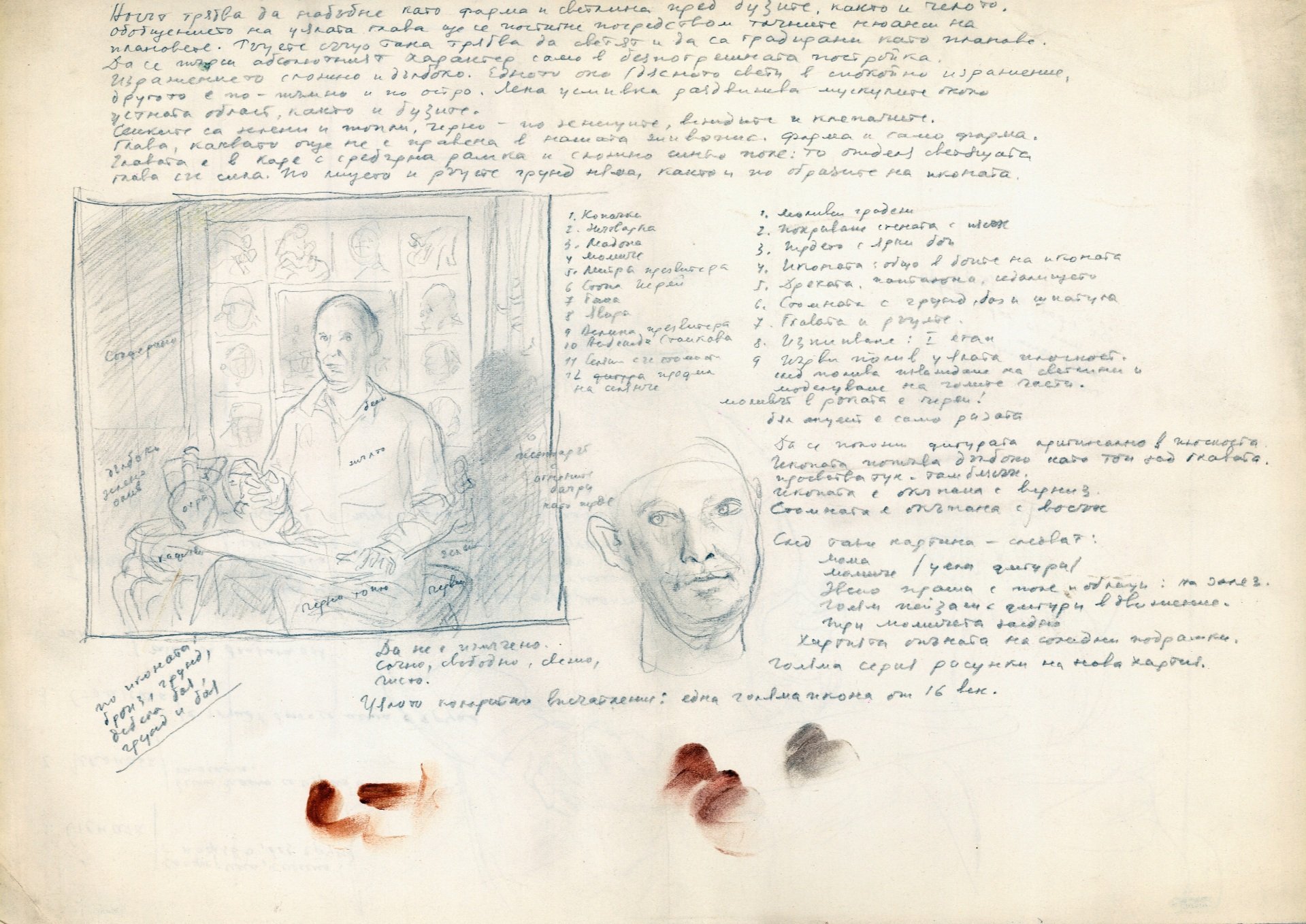004 - Vasil Stoilov
Vasil Stoilov was born on February 29, 1904, in the village of Poduyane (today a Sofia neighborhood) in the Principality of Bulgaria. Vasil is the youngest child in the family of priest Stoil pop Antonov and his wife Mitra Lambova. He grew up with his sister and six brothers in Sofia.
Listen to the full episode:
In this episode, we explore the life and work of the artist and educator Prof. Vasil Stoilov.
The variety of preserved documents, notes, school notebooks, and other archival materials created by the artist helped us to tell his story, relying on his voice and supported by the stories of his relatives.
💭 Whatever you take away from the story, we'd love to hear it. Please share it with us on Instagram or Facebook, or drop us a line at 📧 hello@contours.bg. Happy listening!
Special thanks to Laurel Zmolek-Smith, whose beautiful voice is guiding you through the captivating story of Zlatyu Boyadzhiev, and Maria Kokalanova whose vocal performance adds truly Bulgarian vibes to this episode.
All archival audio recordings have been provided by the Archive Fund of the BULGARIAN NATIONAL RADIO.
Season one of the audio series is made possible thanks to the financial support of the National "Culture" Fund under the "Debuts" program, and in partnership with Alike and ProCasters.
GALLERY
〰️
GALLERY 〰️
IN FRONT OF THE BLANK CANVAS
Vasil Stoilov was born on February 29, 1904, in the village of Poduyane, today a neighborhood in Sofia, Bulgaria. Vasil is the youngest child in the family of priest Stoil pop Antonov and his wife Mitra Lambova. He grew up with his sister and six brothers in Sofia.
Source: University Archives of the NBU, Sofia
BIOGRAPHY [zhivotopis]
Let's start with a manuscript of his “zhivotopis” (i.e.“life writing”), or in modern language, a CV - the resume Vasil wrote when applying for a job at the State Art Academy (also known as the State School of Drawing).
FIRST BRUSHSTROKES AND WORDS ON PAPER
Since early childhood, Vasil Stoilov has written diaries, letters to his brothers, poems about his beloved, or literature homework. Many of these letters and exercises he decorates with small drawings or experiments with different typography styles.
At the same time, Vasil constantly improves his French. Proof of this is his notebooks from high school. There we see how strong his interest in French culture and language and specifically his fondness for Voltaire.









GOSTENKA / FEMALE GUEST
In 1927 (nineteen twenty-seven), I graduated from the Academy under Professor Tseno Todorov. In the same year, for the first time, I took part in a general art exhibition with 4 works, including my first domestic painting "Gostenka". I was 23 years old then. After the opening of the exhibition, Dechko Uzunov came to me one morning, I was with my peers in the salons, and he said: "Come with me!" He led me into one of the halls where in the middle Sirak Skitnik was sitting upright. "Here is Vasil Stoilov," he said. The great critic greeted me with warm words...
- Vasil Stoilov
"Gostenka" [female guest] 1927 | National Gallery, Sofia
PARIS, FRANCE
In 1928, Vasil participated in a competition to receive a state scholarship to specialize in painting in France. Eventually, he won the competition and went to Paris.
For the little over 3 years he spent in the French capital, Vasil painted landscapes and portraits for his patrons and exhibited paintings in some of the most renowned Parisian galleries of his time.
The very first year of my stay in Paris I participated in the Autumn Salon with my work “The Patron”, which was reproduced in the large edition of Hoffman. I participated twice in the Salon of French Artists with the paintings “Mystical Adoration” /1930/, “The Peasant with the Pitcher” and “Fishermen” /1932/, which were reproduced in the catalog of the salon. In 1931 I arranged my own exhibition at the Henri Manuel Gallery, the foreword to the catalog of which was written by the French critic and essayist Louis Reau. In February 1932, at the personal invitation of Camille Mauclair, I participated in the Salon of Figaro arranged by Camille Mauclair with four more works.
- Vasil Stoilov
SOCIALIST REALISM IN THE PEOPLE’S REPUBLIC OF BULGARIA
With the Communist Party coming to power in 1944, artists, especially writers and painters, were obliged to follow the direction of Socialist Realism, as well as the guidelines issued by the Bulgarian Communist Party about everything they create. It becomes difficult for most creators to make a living. They depend on government orders, and cannot negotiate either the prices of their art or the wages for their work. The Bulgarian Communist Party places Socialist Realism in direct opposition to the Formalism Movement popular during the same time in Western Europe. In socialist countries like Bulgaria, Formalistic art is deemed “degenerate”, and painters (as well as artists in general) must distance themselves from this artistic approach.
In Vasil Stoilov's archive, we came across a letter from the chairman of the Bulgarian Artists Union, which accuses Stoilov of violating a state order. The Union’s Chairman Stoyan Sotirov writes to Stoilov:
"The Board of Directors of the Union of Bulgarian Artists learned that the Bulgarian Academy of Sciences has purchased an oil portrait of comrade Gerogi Dimitrov, thereby disregarding the provisions of the existing Ministerial Decree V (five), which prohibits the artist from entering into direct negotiations for the purchase of any works intended for public institutions and placed at public discretion.”
Source: University Archives of the NBU, Sofia
FRESH MILK INSTEAD OF WATER
Stoilov's canvases are diverse, capturing daily life, interiors, still life, landscapes, and portraits. His preferred medium is watercolor paint. The paintings follow the Realism style and are distinguished by the accuracy of drawing, lightness of colors, and attention to detail.
In addition to depicting folk themes, Vasil Stoilov's art is characterized by his unique painting technique. He prefers using watercolor paint. The interesting thing in this case is that he mixes the paints not with water, but with fresh milk.
SKETCHES / CONSTRUCTIONS
In addition to notes for books and analyses, Stoilov also preserved many of his sketches or "constructions", as he often calls them. They mark images, ideas, and reflections on composition tasks. The constructions include the thought process and decisions that Stoilov makes when designing large-scale canvases.
BETWEEN INTENTION AND RESULT
PHILOSOPHY OF CONTRAST
Among everything I've created, much of which I can't recall either what it is or where it is, a few paintings stand out over the decades. And if there are a few, then there are many. It doesn't always happen that a painting is worthy of living. Most often, the product dies before it leaves the studio. But that doesn't mean you shouldn't work. Art is a constant agony and battle between conception and creation.
- Vasil Stoilov
Taken to a general human level, these words also suggest that every day is a constant battle between intention and result, regardless of what we do for a living.
Speaking of contradictions, a contrast between two other popular paintings by Vasil Stoilov is also fascinating. His self-portrait "Hermit", created in 1928, and the triptych "Apotheosis of Native Art", created in 1977. In the first painting, the self-portrait, Vasil depicts himself as a hermit, a person who has withdrawn from society and lives in seclusion. In the second painting, the triptych, we observe a stark contrast. Vasil depicts himself alongside nearly 20 other figures, including both children and adults.
The “Hermit” is on display at the Kvadrat 500 gallery in Sofia. The triptych "Apotheosis of Native Art" is on display at the "Vladimir Dimitrov - Master" Art Gallery in Kyustendil.
“I always remember him with a cigarette in one hand and a paintbrush in the other. He used to say, “This is it, dear daughter, the brush from God, the cigarette from the Devil. Whoever finds the balance between these two beginnings is a true creator.”
- Yavora [Vasil’s daughter]
ACADEMIC ACTIVITY
Professor Vasil Stoilov's contributions to the history of fine art and his lecturing activities are primarily associated with the period between 1953 and 1970.
From 1953 until 1962, Stoilov served as a lecturer—initially as an associate professor and later as a professor—in the Department of Watercolor Painting at the Higher Institute of Civil Engineering in Sofia. The institute is the predecessor of today’s University of Architecture, Civil Engineering, and Geodesy. Between 1964 and 1970, he held the position of professor of painting and served as the head of the Department of Fine Arts at the University of Veliko Tarnovo “St. St. Cyril and Methodius”.
Stoilov actively participated in the artistic and cultural life of Bulgaria until the end of his life. He holds dozens of solo exhibitions and participates in numerous national and foreign general exhibitions. His paintings are owned by galleries and private collectors around the world. In 1989, his paintings were presented at a solo exhibition in Tokyo, and later a permanent exhibition of his works was opened in the city of Niigata (Japan).
Vasil Stoilov died on February 13, 1990, in Sofia.
Sources
Messages: Vasil Stoilov - 110 years since his birth - NBU Archive (in BG)
Video presentation "Pencil constructions" by Prof. Vasil Stoilov - NBU (in BG)
Bulgarian Socialist Realism 1956, 1968, 1989. Norm and Crisis in the Literature of the People's Republic of Bulgaria, authored by Plamen Doykov. Published by the Institute for the Study of Recent Past and "Siela" Publishing House (thanks to Dimitar Dimov from the Institute for the Study of Recent Past)
"History of Bulgarian Fine Art", authored by Kiril Krastev. Publisher: List, 2021.
Vasil Stoilov - painting with a hand on the heart - Archive Fund, BNR (in BG)
I'm locked in by the thought of you... - Kultura magazine (in BG)
"I believe in my path..." [From the artist's correspondence as a young man] - Bibliosphere (in BG)
Vasil Stoilov - Loran Gallery
All archival materials (prints, manuscripts & visuals) have been provided by the University Archives of the New Bulgarian University. Thank you!



![Biography of Vasil Stoilov [typewriter]](https://images.squarespace-cdn.com/content/v1/64fb2e072d9bf70764d3ed30/1707168549365-LCLJB2VLTV2PO5JFVRLE/F2+Op+1+AE+1+L+1.jpg)
![Biography of Vasil Stoilov [typewriter]](https://images.squarespace-cdn.com/content/v1/64fb2e072d9bf70764d3ed30/1707168546943-9N62OSLR75XINLZAKJ47/F2+Op+1+AE+1+L+1+Grub.jpg)
![Biography of Vasil Stoilov [manuscript]](https://images.squarespace-cdn.com/content/v1/64fb2e072d9bf70764d3ed30/1707168547897-CF159EDYAVL05JC5F9VV/F2+Op+1+AE+1+L+1a.jpg)





























